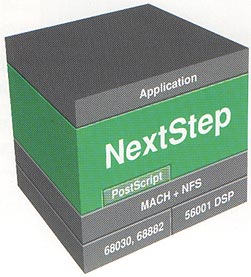|
|
||
|
There are two sides to every computer story. One involves the people who use it, the other involves the people who program it. Macintosh made computer history by revolutionizing the user interface. But while users reaped tremendous benefits, the programmers paid the price. From their point of view, that interface symbolized not only progress, but hundreds of complex routines and serious delays in software development. The NeXT Computer System is unique in its planning, in that it addresses the needs of both users and programmers. In fact, in many instances, it actually begins to blue the distinction between the two. We've created a radically different environment in which software can be developed: NextStep. This new environment cuts development time to a fraction of what it's been in the past, largely because it allows much of a programmer's work to be done graphically. In designing a program, for example, you would use an extraordinary tool called Interface Builder. It provides you with a palette of interface elements (windows, menus, buttons, etc.) that can easily be arranged to make your program look just the way you want it to. NextStep is a world of such "objects." Each is pre-programmed for its own look and function, and ready to plug into new applications. A programmer can use the objects that come with NextStep or create brand-new objects. Existing objects can also be customized to fit precisely into a programmer's vision.Then, simply by connecting objects, new programs can be created or existing ones customized - often with little new programming. And often at the hand of someone who has never before been considered a programmer. Objects exist conveniently in kits. The Application Kit contains approximately forty objects that represent the core of any application, including the user interface. But new kits, devoted to specific areas of interest, will provide users with tools they never had before. A physics professor could construct a myriad of experiments using a Physics Lab Kit. It would contain all the familiar objects in the laboratory, from test tubes to analysis equipment. Interface Builder would make it possible to construct different experiments simply by selecting the appropriate objects and establishing the connections between them. The same concept would apply to every discipline. Only now, instead of taking months to develop customized software for classroom use, it would be a matter of days, perhaps hours. So professors and their assistants could realistically create software within the confines of their busy schedules. In business, NextStep has equally far-reaching potential. For the first time, applications will not only be much easier to develop, they'll be far easier to maintain and upgrade. Because objects can be modified in appearance or function with minimal new programming. And one other important thing to know about NextStep: It's such a remarkable technology, IBM has licensed it for use in their UNIX-based computers. And the fact is, any program developed on one computer using NextStep can easily be ported to another. That adds up to even more good news for the people who will ultimately benefit from this new programming environment: the users. NextStep ensures that we will see more programs, and more powerful programs, in a shorter period of time than has ever been possible on a revolutionary platform. |
||
|
About NextStep. Our goal in creating NextStep was to speed development time and free the programmer from the time-consuming job of constructing and debugging the user interface. To look at it one way, NextStep is acutally made up of four layers that sit atop the UNIX operating system. The Window Server, which keeps an eye on events such as mouse movement and keyboard input, the either handles the event or passes it to the appropriate program; the Workspace Manager, which oversees the graphical interface to the UNIX operating system; the Application Kit, which consists of the programming of objects common to most applications; and Interface Builder, which allows the programmer to graphically design an application interface and define the relationship between objects. Within the Window Server layer is the Display PostScript interpreter, which manages the placement of text and graphics within a window for each program. The NeXT Computer comes with a full development environment, including an ANSI C Compiler with extensions to support Objective-C and a source level debugger.
The foundation for a future of software that's more quickly developed and more easily customized. |
